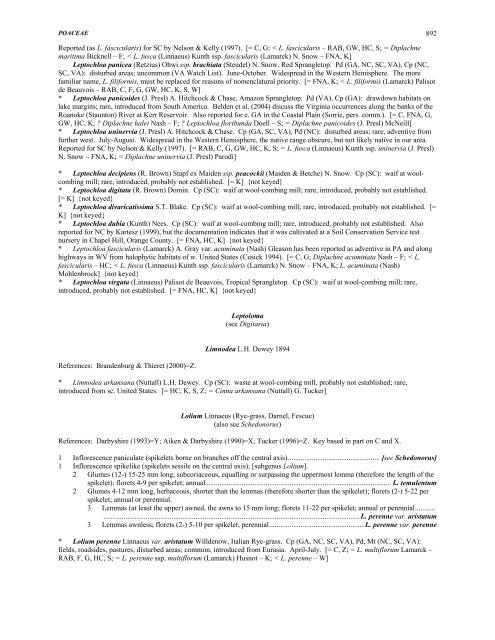Part 7 - UNC Herbarium
Part 7 - UNC Herbarium
Part 7 - UNC Herbarium
You also want an ePaper? Increase the reach of your titles
YUMPU automatically turns print PDFs into web optimized ePapers that Google loves.
POACEAE 892<br />
Reported (as L. fascicularis) for SC by Nelson & Kelly (1997). [= C, G; < L. fascicularis – RAB, GW, HC, S; = Diplachne<br />
maritima Bicknell – F; < L. fusca (Linnaeus) Kunth ssp. fascicularis (Lamarck) N. Snow – FNA, K]<br />
Leptochloa panicea (Retzius) Ohwi ssp. brachiata (Steudel) N. Snow, Red Sprangletop. Pd (GA, NC, SC, VA), Cp (NC,<br />
SC, VA): disturbed areas; uncommon (VA Watch List). June-October. Widespread in the Western Hemisphere. The more<br />
familiar name, L. filiformis, must be replaced for reasons of nomenclatural priority. [= FNA, K; < L. filiformis (Lamarck) Palisot<br />
de Beauvois – RAB, C, F, G, GW, HC, K, S, W]<br />
* Leptochloa panicoides (J. Presl) A. Hitchcock & Chase, Amazon Sprangletop. Pd (VA), Cp (GA): drawdown habitats on<br />
lake margins; rare, introduced from South America. Belden et al. (2004) discuss the Virginia occurrences along the banks of the<br />
Roanoke (Staunton) River at Kerr Reservoir. Also reported for e. GA in the Coastal Plain (Sorrie, pers. comm.). [= C, FNA, G,<br />
GW, HC, K; ? Diplachne halei Nash – F; ? Leptochloa floribunda Doell – S; = Diplachne panicoides (J. Presl) McNeill]<br />
* Leptochloa uninervia (J. Presl) A. Hitchcock & Chase. Cp (GA, SC, VA), Pd (NC): disturbed areas; rare, adventive from<br />
further west. July-August. Widespread in the Western Hemisphere, the native range obscure, but not likely native in our area.<br />
Reported for SC by Nelson & Kelly (1997). [= RAB, C, G, GW, HC, K, S; = L. fusca (Linnaeus) Kunth ssp. uninervia (J. Presl)<br />
N. Snow – FNA, K; = Diplachne uninervia (J. Presl) Parodi]<br />
* Leptochloa decipiens (R. Brown) Stapf ex Maiden ssp. peacockii (Maiden & Betche) N. Snow. Cp (SC): waif at woolcombing<br />
mill; rare, introduced, probably not established. [= K] {not keyed}<br />
* Leptochloa digitata (R. Brown) Domin. Cp (SC): waif at wool-combing mill; rare, introduced, probably not established.<br />
[= K] {not keyed}<br />
* Leptochloa divaricatissima S.T. Blake. Cp (SC): waif at wool-combing mill; rare, introduced, probably not established. [=<br />
K] {not keyed}<br />
* Leptochloa dubia (Kunth) Nees. Cp (SC): waif at wool-combing mill; rare, introduced, probably not established. Also<br />
reported for NC by Kartesz (1999), but the documentation indicates that it was cultivated at a Soil Conservation Service test<br />
nursery in Chapel Hill, Orange County. [= FNA, HC, K] {not keyed}<br />
* Leptochloa fascicularis (Lamarck) A. Gray var. acuminata (Nash) Gleason has been reported as adventive in PA and along<br />
highways in WV from halophytic habitats of w. United States (Cusick 1994). [= C, G; Diplachne acuminata Nash – F; < L.<br />
fascicularis – HC; < L. fusca (Linnaeus) Kunth ssp. fascicularis (Lamarck) N. Snow – FNA, K; L. acuminata (Nash)<br />
Mohlenbrock] {not keyed}<br />
* Leptochloa virgata (Linnaeus) Palisot de Beauvois, Tropical Sprangletop. Cp (SC): waif at wool-combing mill; rare,<br />
introduced, probably not established. [= FNA, HC, K] {not keyed}<br />
Leptoloma<br />
(see Digitaria)<br />
References: Brandenburg & Thieret (2000)=Z.<br />
Limnodea L.H. Dewey 1894<br />
* Limnodea arkansana (Nuttall) L.H. Dewey. Cp (SC): waste at wool-combing mill, probably not established; rare,<br />
introduced from sc. United States. [= HC, K, S, Z; = Cinna arkansana (Nuttall) G. Tucker]<br />
Lolium Linnaeus (Rye-grass, Darnel, Fescue)<br />
(also see Schedonorus)<br />
References: Darbyshire (1993)=Y; Aiken & Darbyshire (1990)=X; Tucker (1996)=Z. Key based in part on C and X.<br />
1 Inflorescence paniculate (spikelets borne on branches off the central axis).................................................. [see Schedonorus]<br />
1 Inflorescence spikelike (spikelets sessile on the central axis); [subgenus Lolium].<br />
2 Glumes (12-) 15-25 mm long, subcoriaceous, equalling or surpassing the uppermost lemma (therefore the length of the<br />
spikelet); florets 4-9 per spikelet; annual .................................................................................................... L. temulentum<br />
2 Glumes 4-12 mm long, herbaceous, shorter than the lemmas (therefore shorter than the spikelet); florets (2-) 5-22 per<br />
spikelet; annual or perennial.<br />
3 Lemmas (at least the upper) awned, the awns to 15 mm long; florets 11-22 per spikelet; annual or perennial...........<br />
........................................................................................................................................... L. perenne var. aristatum<br />
3 Lemmas awnless; florets (2-) 5-10 per spikelet; perennial................................................... L. perenne var. perenne<br />
* Lolium perenne Linnaeus var. aristatum Willdenow, Italian Rye-grass. Cp (GA, NC, SC, VA), Pd, Mt (NC, SC, VA):<br />
fields, roadsides, pastures, disturbed areas; common, introduced from Eurasia. April-July. [= C, Z; = L. multiflorum Lamarck –<br />
RAB, F, G, HC, S; = L. perenne ssp. multiflorum (Lamarck) Husnot – K; < L. perenne – W]













